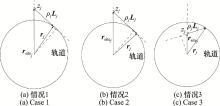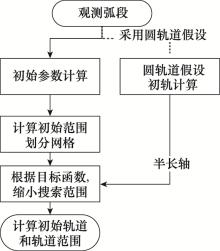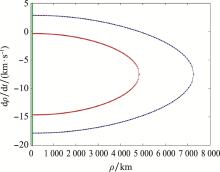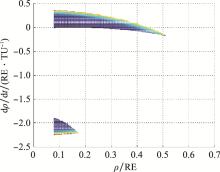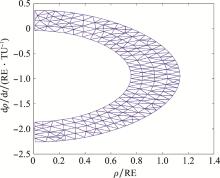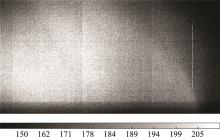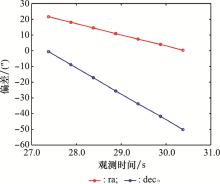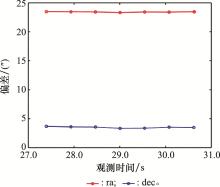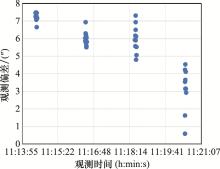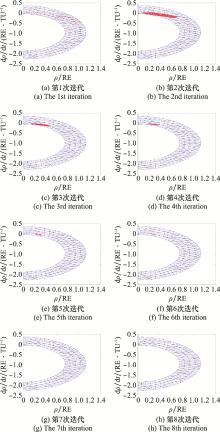Systems Engineering and Electronics ›› 2022, Vol. 44 ›› Issue (8): 2601-2611.doi: 10.12305/j.issn.1001-506X.2022.08.25
• Guidance, Navigation and Control • Previous Articles Next Articles
Initial orbit determination for a near-circular orbit of space debris with space-based short-arcs method and experiment
Dawei LI1,2,3,*, Jing LIU1,2,3, Xiyan PENG1,2, Yao ZHANG1,2,3, Yanhao XIE4
- 1. National Astronomical Observatories, Chinese Academy of Sciences, Beijing 100101, China
2. Space Debris Observation and Data Application Center, China National Space Administration, Beijing 100101, China
3. University of Chinese Academy of Sciences, Beijing 100049, China
4. Chang Guang Satellite Technology Co., Ltd., Changchun 130033, China
-
Received:2021-04-27Online:2022-08-01Published:2022-08-24 -
Contact:Dawei LI
CLC Number:
Cite this article
Dawei LI, Jing LIU, Xiyan PENG, Yao ZHANG, Yanhao XIE. Initial orbit determination for a near-circular orbit of space debris with space-based short-arcs method and experiment[J]. Systems Engineering and Electronics, 2022, 44(8): 2601-2611.
share this article
Table 1
Initial parameters estimation results"
| 参数 | 赤经/(°) | 赤纬/(°) | 赤经变率/((°)/s) | 赤纬变率/((°)/s) |
| 真值 | 286.879 987 | -31.571 968 | 0.031 269 | 0.061 793 |
| 估计值 | 286.877 894 | -31.572 847 | 0.031 315 | 0.061 872 |
| 置信区间下限(95%) | 286.877 855 | -31.572 906 | 0.031 289 | 0.061 823 |
| 置信区间上限(95%) | 286.877 933 | -31.572 789 | 0.031 343 | 0.061 903 |
| 偏差 | 2.08e-03 | -8.89e-04 | 4.44e-05 | 7.78e-05 |
Table 2
Initial orbit and accuracy of admissible region method using 363 s observation"
| 参数 | 半长轴/km | 偏心率/(°) | 轨道倾角/(°) | 升交点赤经/(°) | 近地点角/(°) | 平近点角/(°) | 近地点角+平近点角/(°) |
| 真值 | 7 008.557 | 0.002 | 97.928 | 299.953 | 50.553 | 199.637 | 250.190 |
| 初始轨道 | 7 019.035 | 0.001 | 97.927 | 299.947 | 17.806 | 232.395 | 250.201 |
| 偏差 | 10.478 | -0.001 | -0.001 | -0.006 | -32.747 | 32.758 | 0.011 |
| 标准差 | 9.215 | 0.000 | 0.016 | 0.123 | 0.000 | 0.000 | 0.256 |
Table 3
Initial orbit and accuracy of admissible region method using 244 s observation"
| 偏差项 | 半长轴/km | 偏心率/(°) | 轨道倾角/(°) | 升交点赤经/(°) | 近地点角/(°) | 平近点角/(°) | 近地点角+平近点角/(°) |
| 真值 | 7 008.557 | 0.002 | 97.928 | 299.953 | 50.553 | 199.637 | 250.190 |
| 初始轨道 | 7 027.699 | 0.001 | 97.922 | 299.957 | 317.025 | 293.201 | 250.225 |
| 偏差 | 19.142 | -0.001 | -0.006 | 0.003 | 266.472 | 93.563 | 0.035 |
| 标准差 | 20.444 | 0.001 | 0.033 | 0.253 | 0.000 | 0.000 | 0.524 |
Table 4
Initial orbit and accuracy of admissible region method using 124 s observation"
| 偏差项 | 半长轴/km | 偏心率/(°) | 轨道倾角/(°) | 升交点赤经/(°) | 近地点角/(°) | 平近点角/(°) | 近地点角+平近点角/(°) |
| 真值 | 7 008.557 | 0.002 | 97.928 | 299.953 | 50.553 | 199.637 | 250.190 |
| 初始轨道 | 7 031.524 | 0.001 | 97.928 | 299.874 | 274.728 | 335.331 | 250.059 |
| 偏差 | 22.967 | -0.001 | 0 | -0.079 | 224.175 | 135.694 | -0.131 |
| 标准差 | 47.979 | 0.003 | 0.080 | 0.583 | 0.000 | 0.000 | 1.214 |
Table 5
Initial orbit and accuracy of the circular orbit assumption method using 363 s observation"
| 偏差项 | 半长轴/km | 偏心率/(°) | 轨道倾角/(°) | 升交点赤经/(°) | 近地点角/(°) | 平近点角/(°) | 近地点角+平近点角/(°) |
| 真值 | 7 008.557 | 0.002 | 97.928 | 299.953 | 50.553 | 199.637 | 250.190 |
| 圆轨道 | 7 017.755 | 0 | 97.949 | 299.780 | 0 | 249.738 | 249.738 |
| 偏差 | 9.198 | -0.002 | 0.021 | -0.173 | -50.553 | 50.101 | -0.452 |
Table 6
Initial orbit and accuracy of the circular orbit assumption method using 4 s observation"
| 偏差项 | 半长轴/km | 偏心率/(°) | 轨道倾角/(°) | 升交点赤经/(°) | 近地点角/(°) | 平近点角/(°) | 近地点角+平近点角/(°) |
| 真值 | 7 008.557 | 0.002 | 97.928 | 299.953 | 50.553 | 199.637 | 250.190 |
| 圆轨道 | 7 018.968 | 0.000 | 97.936 | 299.784 | 0.000 | 0.000 | 249.837 |
| 偏差 | 10.410 | -0.002 | 0.008 | -0.170 | -50.553 | 50.200 | 0.353 |
Table 7
Initial orbit and accuracy of the circular orbit assumption+admissible region method using 4 s observation"
| 参数 | 半长轴/km | 偏心率/(°) | 轨道倾角/(°) | 升交点赤经/(°) | 近地点角/(°) | 平近点角/(°) | 近地点角+平近点角/(°) |
| 真值 | 7 008.557 | 0.002 | 97.928 | 299.953 | 50.553 | 199.637 | 250.190 |
| 初始轨道 | 7 040.085 | 0.002 | 97.922 | 299.895 | 263.916 | 346.189 | 250.105 |
| 偏差 | 31.528 | 0.000 | -0.006 | -0.058 | 213.363 | 146.552 | 0.085 |
| 1 | 程昊文. 一种利用空间密度分布生成空间物体轨道的方法[P]. 中国: 201510164403.4, 2015. |
| CHENG H W. A method of generating orbit of space object by using spatial density distribution[P]. China: 201510164403.4, 2015. | |
| 2 | 吴连大, 贾沛璋. 初轨计算中的病态分析[J]. 天文学报, 1997, 38 (3): 288- 296. |
| WU L D , JIA P Z . An analysis of the ill-condition in initial orbit determination[J]. Acta Astronomica Sinica, 1997, 38 (3): 288- 296. | |
| 3 | GOODING R . A new procedure for the solution of the classical problem of minimal orbit determination from three lines of sight[J]. Celestial Mechanics and Dynamical Astronomy, 1996, 66 (4): 387- 423. |
| 4 |
MILANI A , GRONCHI G F , VITTURI M D , et al. Orbit determination with very short arcs. Ⅰ admissible regions[J]. Celestial Mechanics and Dynamical Astronomy, 2005, 92, 1- 18.
doi: 10.1007/s10569-005-3314-7 |
| 5 | MILANI A , GRONCHI G F , KNEŽEVIC' Z , et al. Orbit determination with very short arcs. Ⅱ Identifications[J]. Icarus, 2005, 79 (2): 360- 374. |
| 6 | MILANI A , VILLANI A , STIAVELLI M . Discovery of very small asteroids by automated trail detection[J]. Earth, Moon and Planets, 1972, (1-3): 257- 262. |
| 7 |
MILANI A , SANSATURIO M E , CHESLEY S R . The asteroid identification problem Ⅳ: attributions[J]. Icarus, 2001, 151 (2): 150- 159.
doi: 10.1006/icar.2001.6594 |
| 8 | MILANI A, GRONCH G F. Theory of orbit determination[D]. Cambridge: Cambridge University Press, 2010 |
| 9 |
MILANI A , TOMMEI G , FARNOCCHIA D , et al. Correlation and orbit determination of space objects based on sparse optical data[J]. Monthly Notices of the Royal Astronomical Society, 2011, 417, 2094- 2103.
doi: 10.1111/j.1365-2966.2011.19392.x |
| 10 |
MILANI A . The asteroid identification problem Ⅰ: recovery of lost asteroids[J]. Icarus, 1999, 137, 269- 292.
doi: 10.1006/icar.1999.6045 |
| 11 |
TOMMEI G. , MILANI A. , ROSSI A . Orbit determination of space debris: admissible regions[J]. Celestial Mechanics and Dynamical Astronomy, 2007, 97 (4): 289- 304.
doi: 10.1007/s10569-007-9065-x |
| 12 |
FARNOCCHIA D , TOMMEI G. , MILANI A , et al. Innovative methods of correlation and orbit determination for space debris[J]. Celestial Mechanics and Dynamical Astronomy, 2010, 107 (1-2): 169- 185.
doi: 10.1007/s10569-010-9274-6 |
| 13 |
FUJIMOTO K , SCHEERES D J . Applications of the admissible region to space-based observations[J]. Advances in Space Research, 2013, 52 (4): 696- 704.
doi: 10.1016/j.asr.2013.04.020 |
| 14 |
DEMARS K , JAH M K . Probabilistic initial orbit determination using Gaussian mixture models[J]. Journal of Guidance, Control, and Dynamics, 2013, 36 (5): 1324- 1335.
doi: 10.2514/1.59844 |
| 15 |
WISHNEK S , MARCUS J H , PATRICK H S H . Robust initial orbit determination using streaks and admissible regions[J]. The Journal of the Astronautical Sciences, 2021, 68, 349- 390.
doi: 10.1007/s40295-021-00264-1 |
| 16 | SCHAEPERKOETTER A V. A comprehensive comparison between angles-only initial orbit determination techniques[D]. Texas: Texas & M University, 2012. |
| 17 |
李骏, 安玮, 周一宇. 天基光学短弧初轨的约束微分修正方法[J]. 宇航学报, 2009, 30 (2): 769- 774.
doi: 10.3873/j.issn.1000-1328.2009.02.064 |
|
LI J , AN W , ZHOU Y Y . Constrained differential correction in initial orbit determination with short arcs in optical space-based space surveillance[J]. Journal of Astronautics, 2009, 30 (2): 769- 774.
doi: 10.3873/j.issn.1000-1328.2009.02.064 |
|
| 18 | 李鑫冉. 基于进化计算的极短弧定轨方法[D]. 合肥: 中国科学技术大学, 2018. |
| LI X R. A very short arc orbit determination method based on evolutionary computation[D]. Hefei: University of science and Technology of China, 2018. | |
| 19 | 章品. 一种仅使用角度观测值的空间目标初始轨道确定方法[D]. 武汉: 武汉大学, 2017. |
| ZHANG P. A space target initial orbit determination method using only angle observations[D]. Wuhan: Wuhan University, 2017. | |
| 20 | 吴连大. 人造卫星与空间碎片的轨道和探测[M]. 北京: 中国科学技术出版社, 2012. |
| WU L D . Satellite and space debris orbit and detection[M]. Beijing: China Science and Technology Press, 2012. | |
| 21 | WORTHY J L , HOLZINGER M J . Incorporating uncertainty in admissible regions for uncorrelated detections[J]. Journal of Guidance, Control, and Dynamics, 2015, |
| 22 | GENNARO P, ARMELLIN R, HUGH L. Confidence region of least squares solution for single-arc observations[C]//Proc. of the 17th Advanced Maui Optical and Space Surveillance Technologies Conference, 2016 |
| 23 | WEISMAN R M , MAJJI M , ALFRIEND K T . Analytic characterization of measurement uncertainty and initial orbit determination on orbital element representations[J]. Celestial Mechanics and Dynamical Astronomy, 2013, 118 (2): 165- 195. |
| 24 | VALLADO D A . Fundamentals of astrodynamics and applications[M]. 3rd ed Hawthome: Microcosm Press, 2007: 515- 520. |
| 25 | 刘林, 胡松杰, 王歆. 航天动力学引论[M]. 南京: 南京大学出版社, 2016. |
| LIU L , HU S J , WANG X . Introduction to aerospace dynamics[M]. Nanjing: Nanjing University Press, 2016. | |
| 26 | MONTENBRUCK O . Satellite Orbits: Models Methods and Application[M]. Oliver: Montenbruck. |
| 27 | 马岩, 马驰, 解延浩, 等. 基于视频遥感卫星的空间目标光度测量[J]. 光子学报, 2019, 48 (12): 225- 233. |
| MA Y , MA C , XIE Y H , et al. Space target luminosity measurement based on video remote sensing satellites[J]. Acta Photonica Sinica, 2019, 48 (12): 225- 233. |
| [1] | Kexin ZHAO, Qingbo GAN, Zhitao YANG, Jing LIU. Multiple-roots problem of initial orbit determination of near-Earth object and space target [J]. Systems Engineering and Electronics, 2022, 44(9): 2914-2921. |
| [2] | Huachao WANG, Jing LIU, Haowen CHENG, Xiyan PENG. Fast star map recognition algorithm based on fuzzy decision [J]. Systems Engineering and Electronics, 2022, 44(5): 1447-1453. |
| [3] | Dan SHEN, Jing LIU. Analysis of the impact of large LEO constellation deployment on the space debris environment [J]. Systems Engineering and Electronics, 2020, 42(9): 2041-2051. |
| [4] | Zhitao YANG, Jing LIU, Lin LIU. Improved method of orbit analytical solution and its application [J]. Systems Engineering and Electronics, 2020, 42(2): 427-433. |
| [5] | WANG Weijie, LI Yiyong, LUO Wen, ZHANG Feizhou, ZHANG Jiang. Mission analysis on removal of space debris with spacebased laser [J]. Systems Engineering and Electronics, 2019, 41(6): 1374-1382. |
| [6] | AN Kai. Space debris positioning technology based on stereo vision [J]. Systems Engineering and Electronics, 2013, 35(9): 1841-1845. |
| Viewed | ||||||
|
Full text |
|
|||||
|
Abstract |
|
|||||
